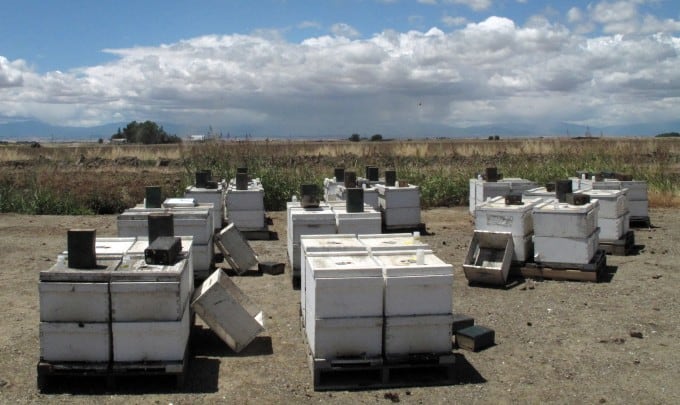
I have been living in Northern CA for just over a year now and from what I’ve been told the weather in the past year has been atypical. Last spring and early summer was late and unusually wet which led to one of the best star thistle crops in years. Because of the rain the star thistle was able to out compete the grasshoppers and produce more than enough flowers to keep the bees busy. Most beekeepers in the area were able to make a surplus of honey and I think the abundance of available forage during the summer months may have helped curb pests and pathogens like Varroa and Nosema. If the bees have the strength and energy provided by healthy natural forage then they are able to fight off things that might otherwise plague the hive. Most beekeepers out here were able to go into winter with full boxes of bees and plenty of food stores. Add a timely Varroa and Nosema treatment in late summer/early fall and the road to almond pollination becomes much less worrisome.
There was really only one month of winter here last year, December. In January and February 2012 there was very little rain with more than a few days where temperatures got up into the 60’s. This makes a few things possible, some of which help to get bees ready for almond pollination. If the weather cooperates beekeepers can get out and feed bees if necessary in order to boost hive populations of winter bees to meet the increasing demand of almond growers request for an 8 frame average of hives being rented for pollination services. Warm weather in January/February also means that the bees can take advantage of natural forage that may or may not be available depending on the location of yards and how many other beekeepers are nearby.
However, bees can sometimes get themselves into trouble if they have nothing to do during long stretches of nice weather in the winter. For example, bees in holding yards waiting to be moved into almond orchards might start to pick on weaker hives in a yard, robbing for food if no natural or supplemental source is available. Robbing can lead to a lot of different things like the spreading of pests and pathogens. In order to head off potential problems such as this most beekeepers will tell you that is why it’s so important to be in their hives at least every two weeks. If they know what is going on in the hives and in the environment around them they can intervene.
Most of the beekeepers we work with commented that their bees did so well during the almond bloom this year that keeping swarming to a minimum became an issue. I have even heard of some beekeepers drowning bees in soapy water to keep populations down as a way to control swarming. This is usually not a problem because by late February/early March most bee breeders in the area have started grafting and as a result shaking bees from field colonies to use in their breeding operations as starters and cell builders. March did not play out as well for the bee breeders as they had hoped. The rain came making queen mating nearly impossible and disrupting the strict schedule bee breeders usually keep which includes shaking excess bees from field colonies.
After a couple of weeks of bad mating weather things cleared up and bee breeders were able to get a handle on things, playing catch up and getting back on schedule. There was a relative dearth of available forage here in April but by May things seemed to turn around. No rain in May and June did help by allowing the bees to get out, store some food, and make brood but it did not help things here for the July and August months.
Because it’s been so dry here there is little to no star thistle in bloom (the grasshoppers got to most of them before they could start producing) and beekeepers are having to feed like crazy to keep their bees going. Some beekeepers have even started feeding pollen substitutes as early as last week, something they wouldn’t typically do until late August. Some have resorted to swapping bees from good locations with bees in not so good locations in attempt to rotate hives on to decent forage. I have heard that many beekeepers in the area are looking to break even this year.
So, from the feast of last year’s star thistle crop to the famine of this year’s, it will be interesting to see how the hives look this fall going into winter…